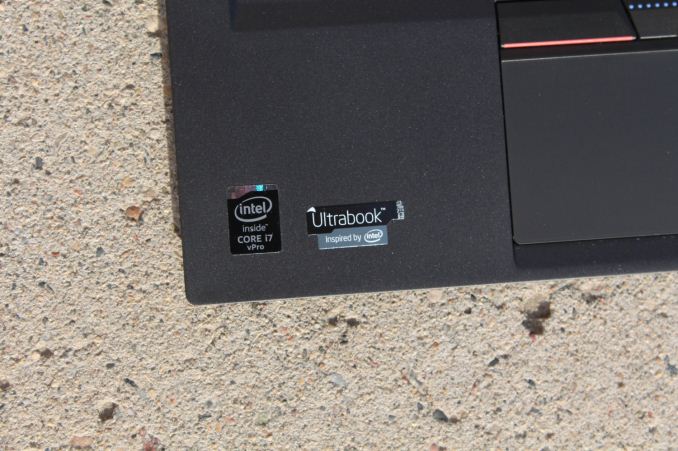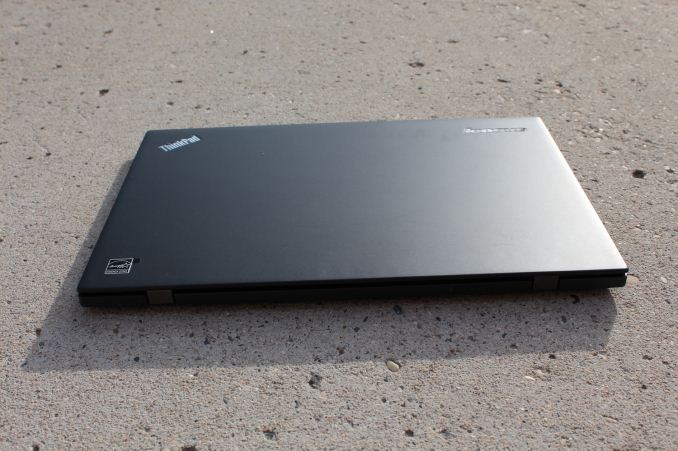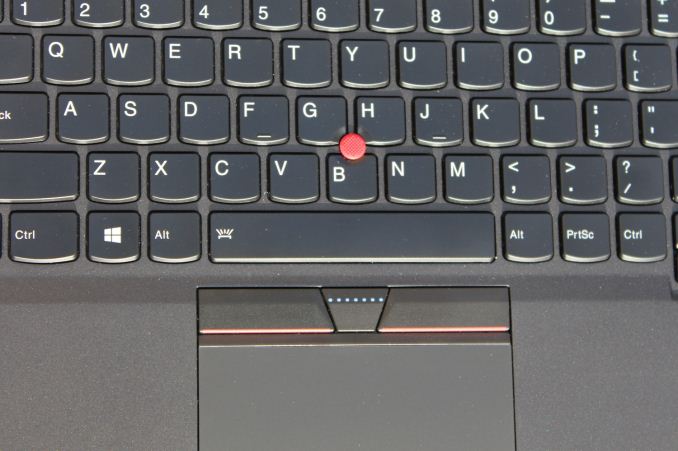The Lenovo ThinkPad X1 Carbon Review (2015)
by Brett Howse on May 21, 2015 8:00 AM EST- Posted in
- Laptops
- Lenovo
- ThinkPad
- Ultrabook
- Broadwell-U
Final Words
The X1 Carbon that Lenovo shipped out for review is likely the fastest Ultrabook yet. The Broadwell Core i7 is certainly a step ahead of the other devices we have tested, and the included PCIe SSD is basically the fastest drive offered today. It is also one of the most expensive Ultrabooks around, with the as-tested price as configured on Lenovo.com at $2100. That is a lot of money for an Ultrabook. The base price is a lot less, but at almost $1100 it is missing some important things like an IPS display and 8 GB of memory. Really the starting configuration is about $1300 once you add those on, and the price can go up again if you opt for more storage.
There is a tremendous amount of competition in the Ultrabook space, so Lenovo needs to differentiate the X1 Carbon and its higher than average price. It does that with the construction to start with. The carbon fibre top is incredibly strong for such a thin display, and the magnesium and aluminum lower half is also very stiff and feels solid. Yet at the same time, the weight of this device is extremely impressive at 2.8 to 3.1 lbs. That is only a hair more than the XPS 13, which has a smaller display and a much smaller body.
The keyboard is also very good on the X1 Carbon, and was likely the most enjoyable keyboard I have had the pleasure of using on an Ultrabook. There are devices out there which are better, but most of them are not this thin, and despite the reduced travel, typing was enjoyable. Lenovo also listened to its customer base and reversed their decision on the function keys, and we see a return of a much more traditional keyboard. I don’t love the Fn and Ctrl keys being reversed as compared to most devices, but it really did not take very long to get used to using it in a new location. For those that can’t adapt, you can go into the BIOS and swap the key functions. The backlighting also was nicely done and has several steps for brightness, and really make it easy to use in a dim setting.
I’m also a big fan of the TrackPoint and I personally find it to be a much more efficient way for me to navigate the GUI. For those that don’t like it, you can disable it (or the trackpad) in the mouse settings and just use the trackpad. Luckily the trackpad is also quite good on the X1 Carbon. There was not any latency that I could detect and it was very accurate with taps, double taps, and scrolling.
The fingerprint reader is also something that I wish was on every notebook. It makes it effortless to log in, and while biometrics may have their detractors, they do allow you to have complex passwords but not have to use them as much, which is going to be more secure than a password like 12345 (which is also the combination of my luggage) and with the Windows Hello initiative coming in Windows 10, there should be a bright future for this kind of login.
Not all is perfect, as with most things. The display is good, but not great. It was great to see Lenovo include an ICC profile but it is too bad that it is not more effective. The display is not overly bright, and the color accuracy is just average. Luckily this was the IPS model though.
The other big detraction was the battery life, which was certainly below expectations. The battery inside is not massive at just 50 Wh, but that means the device needs to be even more efficient, which it is not. Some of that comes down to the X1 Carbon having a physically larger display than most Ultrabooks of course, as well as a higher than average display resolution, but there is likely more to the story. In the end, what matters is the actual battery life, and it could not live up to the lofty results of recent times. At least it charges very quickly, which is a big help.
SIM Slot on the rear of the laptop
A lot of the competition has more USB ports as well, and most have SD card readers built in too. The X1 Carbon has just two USB 3.0 ports and no SD card reader. One partial trade-off is that it does offer a model with LTE connectivity.
Despite the battery life, I really enjoyed using the X1 Carbon. It has an understated look about it which is very traditional ThinkPad, but in a much slimmer design. It is very easy to carry around in a bag, and when you get where you need to go, there is plenty of power on tap to get your work done.














103 Comments
View All Comments
Valantar - Thursday, May 21, 2015 - link
An IBM design? In... 2012, if Google serves me right? After Lenovo bought IBMs whole PC division in 2005? I'd like to see some kind of corroboration, please.While it's true that my experience is limited, my X201 is doing fine after long years of hard usage - the only issue I ever had was an SD reader with slightly subpar performance, which Lenovo promptly replaced as soon as I reported it. Great end-user customer service. The battery even has around 80% of its capacity after all that time.
Compared with the HP ProBook I bought for my mother around the same time, that had constant firmware/driver issues, and failed after about three years of very light usage (display failure). I've heard similar experiences from colleagues using ProBooks and EliteBooks too.
I see a lot of 'ThinkPads suck ever since Lenovo' going around, but I can't help seeing that as a combination of bad luck (getting your first faulty unit after the ownership change) and just plain resistance to change. YMMV.
Samus - Thursday, May 21, 2015 - link
Everyone in my IT circle avoid Lenovo equipment like the plague among all their clients. The one guy who did use Lenovo, exclusively, is in the process of closing his business and dissolving his corporation because of super fish fallout and generally unhappy customers due to poor Lenovo support. Reliability is indeed s YMMV but with hp elitebook a they come the next day to your door and rebuild the thing in front of you for 3 years.sandy105 - Friday, May 22, 2015 - link
funny guy ..T2k - Friday, May 22, 2015 - link
Oh PLEAHHSE. I literally don't know ANYONE with an HP laptop in my immediate circles but every AWS, Rackspace, SIGGRAPH etc conference I still see a LOT OF Thinkpads, even regular Lenovo laptops, stop spreading BS, please.Samus - Friday, May 22, 2015 - link
You obviously do not realize that HP Corporate is twice as large as Lenovo's Corporate presence. HP commands around 70% of the world server market where as about 15 other companies make up the remaining 30%. Proliants literally run the world.As far as laptops, the US military has used Elitebooks exclusively for years...and very few healthcare sectors use Lenovo for the same reason: they're a Chinese company.
But there is no real debating that Elitebooks are better than Thinkpads dollar for dollar. Stop thinking of Best Buy when you think of HP equipment. Best Buy sells to suckers, not enterprise. I I can't find the article right now and I'm pretty sure it was Forbes or WSJ but I read nearly half of fortune 500 companies are exclusively HP houses. It also helps HP is in the printer business so companies can keep their accounts in one place.
Does any of this make HP better than Lenovo? No. But if you've ever actually disected an Elitebook next to a modern day Thinkpad you'd quickly realize, if you have any concept of quality, that the Elitebook was designed by brighter minds with less cut corners.
The only reason Lenovo has overtaken HP in sales over the past two years comes down to economies of scale: Lenovo can mass produce more crap than HP can, so they are cheaper. In this economy people are buying based on price, not quality. Look how many KIA's and Chrysler's are on the road.
CoolRunnings - Wednesday, May 27, 2015 - link
Actually the army uses Dell Latitudes last I saw... I've got hundreds of Thinkpad T420 and T430 laptops in my customers hands and have had the fewest number of issues with those of any series of laptop I've used. They're not perfect by any stretch but all those griping about Lenovo having ruined the Thinkpad brand since 2006 must have forgotten the terrors of the T40-T42 series and their GPU from hell problems or the brittle plastic on the T20 series. I've worked on Thinkpads since the T20 came out and the T420-T430 series have by far been the best built in my experience. The keyboard in the T60's was better in some ways though. Now when you start talking of the T440+, yep, agreed, they tend to suck in comparison...T2k - Friday, May 22, 2015 - link
Same thing here, my ~5 years old X201 is still working (sans a loose power connector and the Thinklight that usually refuses to turn on.) I would never trade it for any HP, sorry. Heck, I'd rather get a VAIO with their hybrid graphics any day than an overpriced, bloatware-ridden HP, that's for sure.Samus - Thursday, May 21, 2015 - link
Casualuker, you are an idiot. The last ibm design were the T40 and X40 series. Lenovo was allowed to use the IBM logo on the abysmal T60 series under license but the 60 series were Lenovo design and had chronic reliability problems ranging from failing cathod inverters to warped cooling fans.The T43 and X41 were the last good thinkpads. I still see them in use on occasion...15 years later. Some X40 series machines even have 60gb ssd's.
CasualUker - Friday, May 22, 2015 - link
@Samus, if you say so. The truly last bit of IBM imprints where the Tx30 series. If you don't believe me that's fine.Samus - Friday, May 22, 2015 - link
I don't need to believe you, because you are wrong.http://forum.thinkpads.com/viewtopic.php?t=72128
Lenovo hasn't had license to use the IBM logo since 2005. You are confusing the IBM logo with a Thinkpad logo or something...because there are NO IBM LOGO'S on the last decade of Lenovo Thinkpad, ThinkCentre, ThinkServer, and so on...